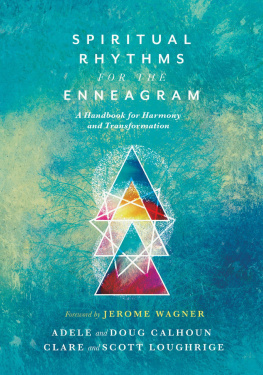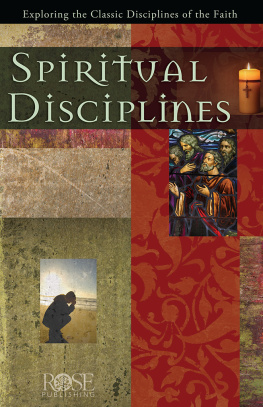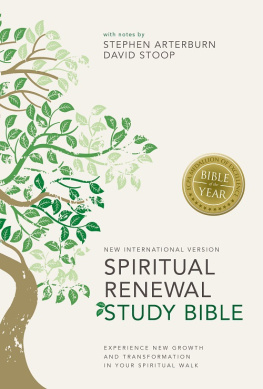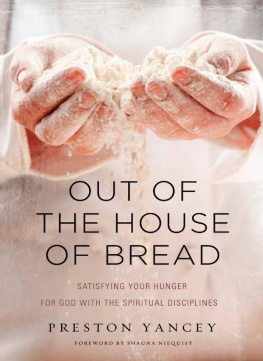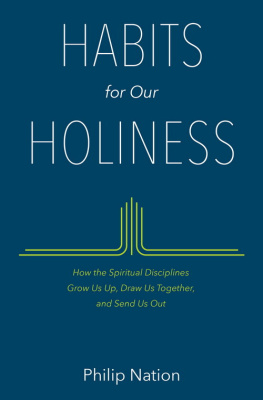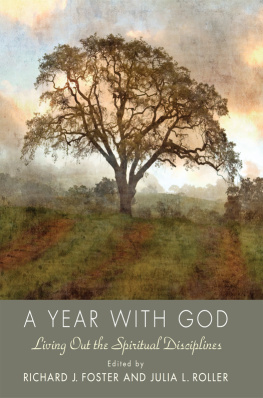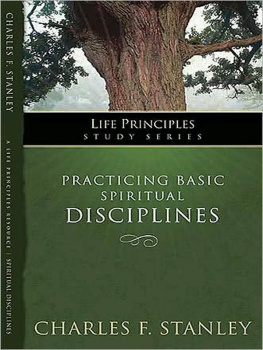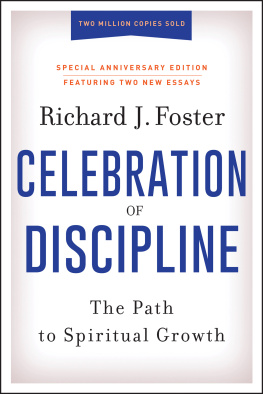SPIRITUAL
DISCIPLINES
HANDBOOK
Practices That Transform Us
REVISED AND EXPANDED
Adele Ahlberg Calhoun

For fellow pilgrims at
Christ Church of Oak Brook,
Park Street Church, Boston, and
IVCF/IFES.
Your desires for God have graced my journey.
Contents
Preface to the Revised Edition
In November 2010 I spent eight days writing icons on Enders Islanda fantastically small dollop of beauty off the coast of Mystic, Connecticut. Corralled by the Atlantic, my world shrank down to a monastic cell, the art studio, daily Mass and meals with strangers.
Icon writing is an exercise in prayer, theology and painting. I am an amateur (to put a finer point on ita novice) in all three fields. But the word amateur expresses my love of these three disciplines. It seemed risky to honor all three loves at once; I might end up slighting God, theology or the saint I was to paint. Or perhaps I would fall in love with them all over again.
The process of icon writing began with Mass and a blessing of the hands of each would-be iconographer. Anticipating the rigors and challenges ahead of us, the priest anointed our hands with oil. Making the sign of the cross, he prayed, I anoint your hands for every good work and for the honor and glory of God. The blessing poured calm over my anxiety and clarified the call and task at hand. I was here to apprentice myself to a master iconographer. Still, I remained clueless of the humbling ahead of me. There would be messes, mistakes, weakness, immaturity, ignorance, fear, inexperience, comparison and the unflagging desire for more.
My fellow students included experienced iconographers (one a member of the British Association of Iconographers) and neophytes like myself. My teacher, Dmitri Andreyev, guided the class with his artistic know-how, theological heft and Russian accent. Lessons began with prayer and without introductions. Dmitri handed each of us a wood panel and launched into the architecture of the universe as revealed in our 12 x 8 x 1 boards. An icons genesis begins with listening to the wood.
The Tree of Life
No tree is just a tree. Trees carry theology in their veins. With branches stretched to the heavens in praise, trees are Gods one creation that join heaven and earth. A tree (like an icon) is a visual shorthand and a symbol of Gods redemption story. The tree of the knowledge of good and evil, the tree of life, the tree for the healing of the nations, the tree of the crossall bear witness to Gods story. Each tree reminds us of Gods presence and action in our world. In Orthodoxy G. K. Chesterton said the chief aim of Christianity was to give room for good things to run wild. Trees reflect those riotous, wondrous truths.
Icons are written on the vertical grain of boardsthus maintaining the branches upward reach to God. Each icon acts as a bridge between heaven and earthholding forth the word of life. The tree of life in Eden and the tree of life in the New Jerusalem both communicate Gods intention to bless, sustain, heal and abide with us forever. The board points to this divine purpose. It also reminds us that the Son of God, with arms nailed wide open to a tree, gave his life for the life of the world. Holding the board in my hand I trace the veins with my fingers. I lift my heart up, and the promise of the new creation opens before me.
Gods Universe on a Panel Board
Icons are written rather than painted, because they communicate. Created with prayer and theologyalso communicationicons are meant to be read. My reading lessons began before I ever held a paintbrush. They began with listening to the woods story.
When we understood the visual shorthand of the wood, Dmitri turned to the gesso-covered side of the board and continued the reading lessons. Gesso is a mixture of organic compounds: animal glues, plaster, chalk and white pigment. The whiteness represents the uncreated light of the Creator. The light that God shares to give life to the world. Refract light through a prism and a spectrum of colors appears. The white surface will ultimately be enfleshed with color, reminding us that every shade, hue, tint and tone finds its origin in the uncreated light of God.
Between the gesso and the board is a layer of muslin or canvas (pavoloka). Dmitri wanted us to see that we had a trinitarian board: all three layers cohere in relationship to one another. The gesso represents the uncreated God of light: God over and above me. The board itself represents Jesus, the tree of life: God with us. The pavoloka represents the Holy Spirit, the breath of God, the kiss between the Father and the Son: God within me. We cant see the pavoloka (literally meaning veil). It is hidden between the wood and the gesso. But it is this invisible Spirit that communicates who Jesus is. Together Creator, Son and Spirit (board, pavoloka and gesso) imprint their image (imago Dei) on humankind.
Once the icon is written it communicates, and like a map guides us into the mystery of Trinity imprinted in human likeness. The board speaks of how the Holy Three create and then stick with their creation when it rebels. Its not some mystical mumbo jumbo but a reservoir of truth deeper, thicker, stronger, wiser, higher than I know. Dmitri quotes from 1 Corinthians 2:10: The Spirit searches all things, even the deep things of God. And Dmitri tells us to contemplate how the God of uncreated lightall sufficient, eternal and holyout of goodness and bounty says let there be and there is! Starfish, nimbus clouds, cocker spaniels and above all these you and me, Gods own image bearers.
These are my first lessons in learning to read the creation history written in the board, gesso and pavoloka. I still have not held a paintbrush. Hours go by. Dmitri turns our attention to the frame and the four corners of the board, and how they limit space. Gods creation has edges and limits, and as such is distinct from the Creator. In transcendence God is beyond all categories and theories and unlike the creation. Still the Creator can be known because creations voice speaks of God (Psalm 19). The icon I am waiting to create will also speak. It will become a living and visual prayer, what I believe will be expressed not just in my words but in what I do with my hands. The way of Jesus is faith in action.
Dmitri taught us step by step. He didnt reveal the whole twenty-one-step process the first day lest he overwhelm and discourage us. As we progressed, he taught us the how-to and the spiritual meaning of mixing egg tempera; laying gold leaf; floating first, second and third lights; and on and on. If someone balked and said, I dont want to paint the eyes or I cant grind the pigment small enough, Dmitri characteristically responded with trust God or pray. Then he would patiently sort through our messes and help us turn it into a thing of beauty. This is the way of a master.
On the last day of class I spilled a small drop of water on my icon. This small drop ate all the way through the egg tempera leaving a small white-hole of gesso. Thinking I could fix it I tried to puddle some paint and repair the hole. I only made it worse. Unhappy with myself, I walked up to Dmitris desk and said, I spilled water on my painting.
He replied, And then you tried to fix it?
Yes, I said.
Looking directly at me he said, What do you know about repairing icons? Why did you think you could fix it? It takes years to learn how to repair icons. Go back to your seat, and I will come help you later.
Chastened, I returned to the task at hand. Time passed. Dmitri helped others. But he didnt come to my desk. Several hours later I went to his desk and said, I have waited patiently for your help.
Next page

